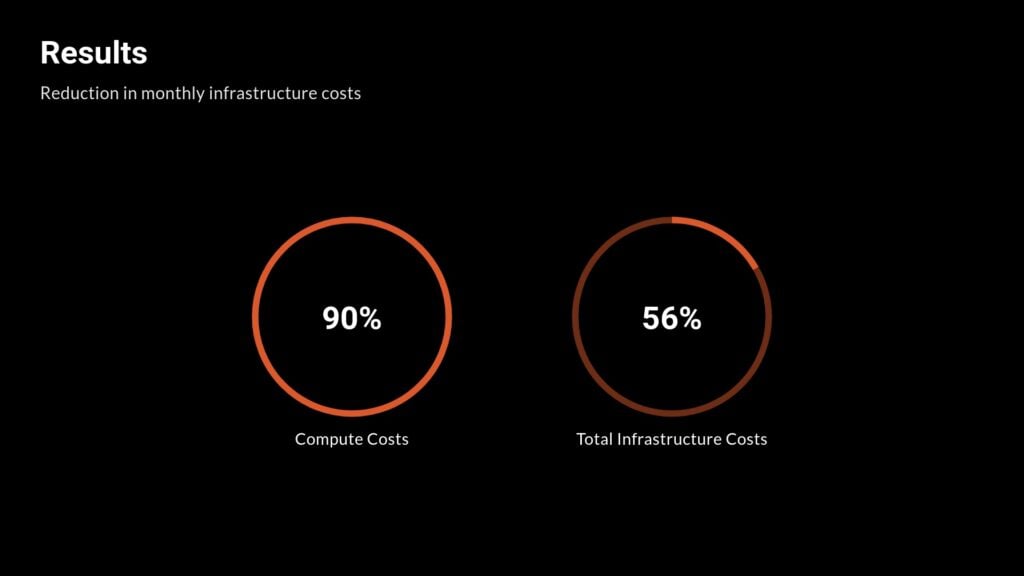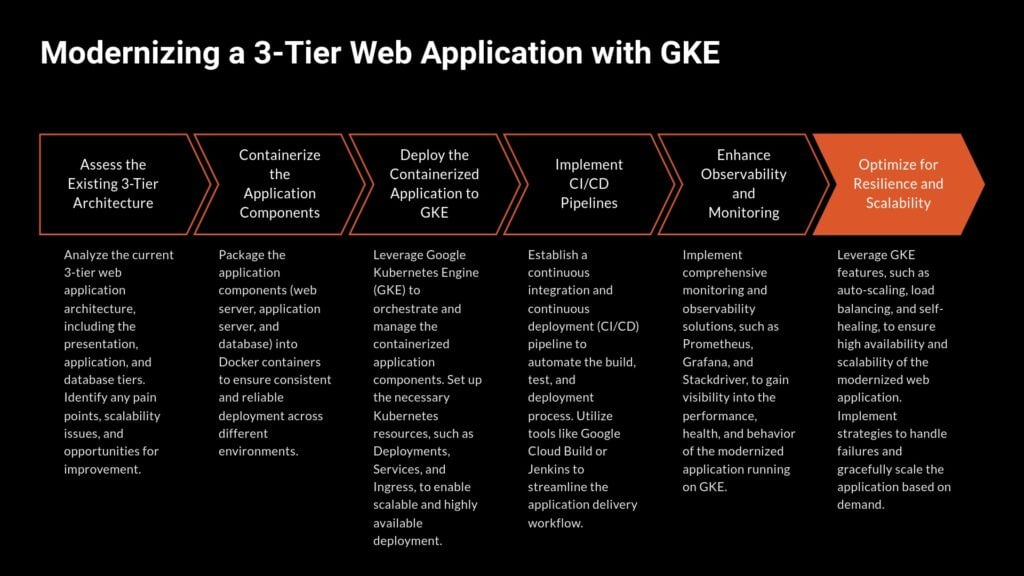Escalating Costs, Growing Demands: A Need for Change
A leading online auto parts retailer faced a critical challenge: their cloud infrastructure was becoming a financial burden. After migrating to Google Cloud Platform (GCP), they found themselves struggling with high Windows licensing fees, inefficient scaling, and an application architecture that wasn’t optimized for modern cloud environments.
As peak sales season approached, the stakes were high. The company needed a cost-effective solution that could scale seamlessly to meet demand—without compromising performance. However, their in-house team lacked experience with containerization, making a transition to Kubernetes daunting.
How could they modernize their infrastructure, reduce costs, and ensure resilience without disrupting their core business operations?

Challenges: Roadblocks to Cost Efficiency and Scalability
Before implementing a solution, the company faced several significant hurdles that were limiting their ability to scale efficiently and cost-effectively.
1. Skyrocketing Licensing and Infrastructure Costs
Following their migration to Google Cloud Platform (GCP), the company found themselves burdened with unexpected costs. Their application ran on Windows-based virtual machines (VMs), and the associated licensing fees were substantial. Even with cloud-native scaling capabilities, these costs made their infrastructure financially unsustainable. The team needed an alternative that could reduce their dependency on expensive Windows instances without disrupting business operations.
2. Limited Kubernetes and Containerization Experience
The company recognized that Kubernetes (GKE) offered a path to greater scalability and efficiency, but their internal development team had little experience with containerized workloads. Moving from traditional VMs to a container-based architecture required rethinking their deployment strategy, optimizing applications for Kubernetes, and reworking development workflows. Without in-depth Kubernetes expertise, the risk of misconfigurations, downtime, or inefficiencies was high.
3. Inefficient and Unreliable Scaling Strategies
The retailer’s high-throughput, three-tier web application handled thousands of transactions per day. However, its scaling logic relied on CPU utilization as the primary metric—an approach that was proving ineffective. Many of the application’s workloads consisted of long-running processes, meaning that spikes in traffic didn’t always correspond to immediate CPU usage. As a result, auto-scaling often lagged behind real demand, leading to periods of under-provisioning (causing slow performance) or over-provisioning (wasting cloud resources).
4. Complex Workflows Leading to Deployment Bottlenecks
The company’s existing CI/CD pipeline was outdated, requiring manual intervention at multiple stages. This slowed down the development cycle, increased the risk of human error, and made it difficult to deploy changes quickly. As the company aimed to scale its operations, they needed an automated pipeline that could integrate seamlessly with their new cloud-native infrastructure.
5. Risk of Downtime and Performance Degradation
With an impending peak sales season, any downtime or performance issues could directly impact revenue. Their existing infrastructure was not designed for rapid scaling, and any misstep in migration could introduce instability. They needed a solution that would not only modernize their system but also maintain—if not improve—availability and resilience.
Each of these challenges had to be addressed to ensure a smooth transition to a modern, cloud-native architecture that balanced performance, cost efficiency, and scalability.
The Solution: A Cloud-Native Transformation for Cost Efficiency and Resilience
To overcome these challenges, we implemented a strategic modernization plan that leveraged containerization, automation, and intelligent scaling. The goal was to reduce costs, enhance scalability, and improve operational efficiency—without disrupting business continuity.
1. Containerization and Migration to Kubernetes (GKE)
To eliminate high Windows licensing costs, we transitioned the company’s application from Windows-based virtual machines to a Linux-based Google Kubernetes Engine (GKE) cluster. This shift not only removed the licensing burden but also unlocked the benefits of Kubernetes, including automated scaling, improved resource utilization, and better fault tolerance.
Since the company had limited Kubernetes experience, we worked closely with their development team to containerize the application, breaking it down into manageable, scalable microservices. This process involved:
- Refactoring legacy components to ensure compatibility with Kubernetes.
- Creating Dockerized environments to standardize deployment across development, staging, and production.
- Designing Kubernetes manifests for automated deployments and infrastructure as code (IaC).
This modernization laid the foundation for a flexible, cloud-native architecture that could scale efficiently and cost-effectively.
2. CI/CD Automation for Seamless Deployments
The company’s previous deployment process was slow and labor-intensive, requiring manual intervention. To streamline this, we implemented a CI/CD pipeline using GitHub Actions and ArgoCD, enabling fully automated builds, testing, and deployments. Key improvements included:
- Automatic container image builds upon code commits.
- Integrated security scanning to catch vulnerabilities early.
- Continuous deployment to Kubernetes, reducing deployment times from hours to minutes.
This shift significantly improved development velocity, reduced errors, and allowed the team to roll out updates seamlessly, minimizing downtime.
Also See: Stop the DDoS Attacks on your Kubernetes Cluster
3. Intelligent Scaling with Custom Metrics
Since CPU-based scaling was ineffective for their workload, we developed a custom metric-driven scaling strategy tailored to the application’s real-time transaction demands. Instead of relying solely on CPU utilization, we introduced:
- Application-level metrics such as request queue depth and response times.
- Custom horizontal pod autoscaling (HPA) based on business-driven thresholds.
- Predictive scaling models using historical traffic patterns to preemptively adjust resources.
By aligning scaling decisions with real application behavior, we optimized cloud resource allocation, reducing both under-provisioning (slow response times) and over-provisioning (excess cloud costs).
4. Cost Optimization with Spot Instances
To further cut infrastructure costs, we leveraged Google Cloud’s preemptible VMs and spot instances, which offer compute power at a fraction of the price of standard instances. Since spot instances can be reclaimed by Google at any time, we implemented:
- Workload-aware scheduling to ensure critical processes always ran on stable instances.
- Fault-tolerant architectures that gracefully handled instance preemptions without service disruption.
This approach led to an estimated 90% reduction in compute costs, making cloud operations significantly more cost-efficient.
5. Enhanced Resilience and High Availability
Since downtime was a major concern, we designed the new architecture with built-in fault tolerance and redundancy:
- Multi-zone Kubernetes deployments to ensure availability even if a regional failure occurred.
- Automated failover mechanisms to reroute traffic instantly in case of disruptions.
- Self-healing infrastructure, where Kubernetes automatically restarted failing services.
These improvements ensured that the company’s platform could handle peak traffic seamlessly while maintaining high uptime and reliability.
This solution transformed the company’s cloud architecture into a cost-efficient, highly scalable, and resilient system. Up next, we’ll explore the measurable impact these changes had on their business.
The Results: Dramatic Cost Savings and Enhanced Performance
By implementing a cloud-native architecture, the company achieved significant improvements across cost, scalability, and operational efficiency. The results were immediate and impactful.

1. Nearly 90% Reduction in Compute Costs
One of the most substantial wins came from leveraging Linux-based containers and GCP spot instances, which slashed compute costs by nearly 90%. By eliminating Windows licensing fees and intelligently utilizing spot instances, the company significantly lowered its cloud spend while maintaining performance.
2. 56% Reduction in Total Infrastructure Costs
Beyond compute savings, optimizations in scaling, workload distribution, and automation led to an overall 56% reduction in monthly infrastructure costs. This freed up budget for other critical business initiatives while ensuring future cost predictability.
3. Faster, More Efficient Scaling
With the introduction of custom metric-based scaling, the company achieved:
- 40% reduction in resource waste by provisioning only what was needed.
- 50% faster response times during peak traffic, improving user experience.
- Seamless handling of high transaction volumes without over-provisioning.
The application could now adapt dynamically to real-time demand, ensuring that resources were used efficiently at all times.
4. Zero Downtime During Peak Sales Season
Previously, the company risked service slowdowns or outages during high-traffic periods. With automated failover mechanisms, multi-zone Kubernetes deployments, and self-healing infrastructure, they experienced zero downtime even during peak sales events.
5. Deployment Time Reduced from Hours to Minutes
The new CI/CD pipeline revolutionized the company’s deployment workflow. Updates that once took several hours of manual effort were now completed in minutes, with zero downtime. This enabled:
- Faster iteration on new features and bug fixes.
- Reduced human error and improved security through automated testing.
- A more agile development cycle, allowing the company to respond quickly to market needs.
A Future-Proofed, Scalable Foundation
With a fully modernized, cost-efficient, and highly scalable cloud infrastructure, the company is now positioned for long-term growth. Their operations are more resilient, their cloud spend is optimized, and their team can deploy faster than ever before.

